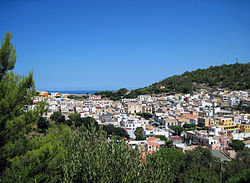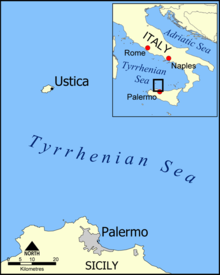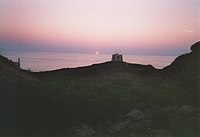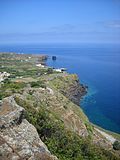You can help expand this article with text translated from the corresponding article in Italian. (March 2022) Click for important translation instructions.
|
| Ustica | |
|---|---|
| Comune | |
| Comune di Ustica | |
 View of Ustica View of Ustica | |
| Location of Ustica | |
  | |
| Coordinates: 38°42′19″N 13°10′34″E / 38.70528°N 13.17611°E / 38.70528; 13.17611 | |
| Country | Italy |
| Region | Sicily |
| Metropolitan city | Palermo (PA) |
| Government | |
| • Mayor | Aldo Messina |
| Area | |
| • Total | 8.24 km (3.18 sq mi) |
| Elevation | 49 m (161 ft) |
| Population | |
| • Total | 1,330 |
| • Density | 160/km (420/sq mi) |
| Demonym | Usticesi or Usticani |
| Time zone | UTC+1 (CET) |
| • Summer (DST) | UTC+2 (CEST) |
| Postal code | 90010 |
| Dialing code | 091 |
Ustica (Italian pronunciation: [ˈustika]; Sicilian: Ùstica) is a small Italian island in the Tyrrhenian Sea. It is about 5 kilometres (3 mi) across and is situated 52 kilometres (32 mi) north of Capo Gallo, Sicily. Roughly 1,300 people live in the comune (municipality) of the same name. There is a regular ferry service from the island to Palermo in Sicily.
History
| This section needs additional citations for verification. Please help improve this article by adding citations to reliable sources in this section. Unsourced material may be challenged and removed. Find sources: "Ustica" – news · newspapers · books · scholar · JSTOR (March 2022) (Learn how and when to remove this message) |
Excavations begun in 1989 at Tramontana, also known as Faraglioni, have unearthed what was a large prehistoric village dating from the 14th to the 13th century BC. The foundations of some 300 stone-built houses were discovered, and the defensive walls of the settlement are among the strongest fortifications of any period known in Italy. It is believed that these early settlers came over from the Aeolian Islands.
In historic times, the island has been populated at least since about 1500 BC by Phoenician peoples. In ancient Greece, the Island was named Osteodes (ossuary) in memory of the thousands of Carthaginian mutineers left there to die of hunger in the 4th century BC. The Romans renamed the island Ustica, Latin for burnt, for its black rocks. The island is also known locally as the "black pearl".
In the 6th century, a Benedictine community settled in the island, but was soon forced to move because of ongoing wars between Europeans and Arabs. Attempts to colonize the island in the Middle Ages failed because of raids by Barbary pirates.
In the mid-18th century, the island was settled by approximately 90 people from the island of Lipari, an island also located north of Sicily, but east of Ustica. They brought with them the patron saint of Lipari, Bartholomew the Apostle, who became the patron saint of Ustica as well. In the mid-to-late 19th century and early 20th century, as the population of the island grew too large, hundreds of Ustican families emigrated to the United States. Many of these families settled in New Orleans and surrounding areas, where there are today thousands of descendants whose ties remain strong to Ustica. Among them was Angelina Caravella, the mother of famous jazz singer and trumpet player Louis Prima. A smaller number of families settled in San Jose and San Francisco, in New York, Massachusetts, Oregon, Montana and in Chicago.
Fascist prison island
During the Fascist years in Italy and until the 1950s, Ustica was used as an island prison. Benito Mussolini banished thousands of political opponents to Ustica, often as many as 1,500 at a time; many were homosexuals. Both Antonio Gramsci and Amadeo Bordiga were sent there. In the early 1940s Yugoslav war prisoners were crammed onto the island, and many of them died from malnutrition and tuberculosis. In the 1950s they were followed by suspected Mafiosi expelled from Sicily.
Ustica Massacre
Main article: Ustica MassacreOn 27 June 1980, Itavia Flight 870 crashed into the sea off the island while en route to Palermo, killing all 81 people on board. The event became known as the Ustica massacre.
Environment

The island has limited sources of water, and vegetation is consequently scarce. The coast has numerous rocks and grottoes.
Ustica is home to the honeybee Apis mellifera sicula.
Tourism
Ustica is particularly known for scuba diving, with a number of diving schools established on the island. Recreational divers are attracted by the relatively deep dives, which are a feature of the island's volcanic geology.
Archaeology
Ustica contains the remains of the Bronze Age settlement of Villaggio dei Faraglioni. It showcases organized urban planning with huts and narrow roadways along its northern periphery, representing a well-preserved example of ancient Mediterranean civilization between 1400 and 1200 BC. Recent archaeological investigations unveiled a sophisticated fortification system beneath the village. Using non-invasive techniques such as ground-penetrating radar and electrical resistivity tomography, researchers identified an 820-foot-long arc-shaped stone wall, standing 13 to 16 feet tall.
Climate
Ustica's climate is classified as hot-summer mediterranean climate (Köppen: Csa). The annual average temperature is 18.13 °C (64.6 °F), the hottest month in July is 26.58 °C (79.8 °F), and the coldest month is 11.27 °C (52.3 °F) in February. The annual precipitation is 525.72 millimetres (20.70 in), of which October is the wettest with 78.85 millimetres (3.10 in), while July is the driest with only 3.91 millimetres (0.15 in).
| Climate data for Ustica, elevation: 250 m or 820 ft, 1991-2020 normals, extremes 1946–present | |||||||||||||
|---|---|---|---|---|---|---|---|---|---|---|---|---|---|
| Month | Jan | Feb | Mar | Apr | May | Jun | Jul | Aug | Sep | Oct | Nov | Dec | Year |
| Record high °C (°F) | 22.4 (72.3) |
23.0 (73.4) |
26.0 (78.8) |
27.2 (81.0) |
33.2 (91.8) |
37.6 (99.7) |
43.0 (109.4) |
39.0 (102.2) |
36.8 (98.2) |
32.2 (90.0) |
27.6 (81.7) |
22.8 (73.0) |
43.0 (109.4) |
| Mean daily maximum °C (°F) | 13.9 (57.0) |
13.7 (56.7) |
15.5 (59.9) |
17.8 (64.0) |
21.7 (71.1) |
26.1 (79.0) |
29.4 (84.9) |
30.3 (86.5) |
26.7 (80.1) |
23.0 (73.4) |
18.8 (65.8) |
15.3 (59.5) |
21.0 (69.8) |
| Daily mean °C (°F) | 11.7 (53.1) |
11.3 (52.3) |
12.8 (55.0) |
14.9 (58.8) |
18.5 (65.3) |
22.6 (72.7) |
25.8 (78.4) |
26.6 (79.9) |
23.6 (74.5) |
20.4 (68.7) |
16.4 (61.5) |
13.1 (55.6) |
18.1 (64.6) |
| Mean daily minimum °C (°F) | 9.5 (49.1) |
8.8 (47.8) |
10.2 (50.4) |
12.0 (53.6) |
15.3 (59.5) |
19.1 (66.4) |
22.1 (71.8) |
23.0 (73.4) |
20.5 (68.9) |
17.7 (63.9) |
14.0 (57.2) |
10.9 (51.6) |
15.3 (59.5) |
| Record low °C (°F) | −1.2 (29.8) |
0.5 (32.9) |
−1.2 (29.8) |
3.6 (38.5) |
6.4 (43.5) |
10.0 (50.0) |
14.0 (57.2) |
14.2 (57.6) |
12.2 (54.0) |
7.6 (45.7) |
3.0 (37.4) |
−1.0 (30.2) |
−1.2 (29.8) |
| Average precipitation mm (inches) | 60.4 (2.38) |
52.9 (2.08) |
39.2 (1.54) |
34.0 (1.34) |
18.5 (0.73) |
11.6 (0.46) |
3.9 (0.15) |
20.8 (0.82) |
60.7 (2.39) |
78.9 (3.11) |
72.5 (2.85) |
72.3 (2.85) |
525.7 (20.70) |
| Average precipitation days (≥ 1.0 mm) | 8.7 | 7.6 | 6.3 | 5.3 | 3.2 | 1.5 | 0.7 | 1.8 | 5.2 | 7.4 | 9.4 | 10.0 | 67.1 |
| Average relative humidity (%) | 79.0 | 77.5 | 77.5 | 76.6 | 74.7 | 73.5 | 73.0 | 73.6 | 76.5 | 78.4 | 77.3 | 77.8 | 76.3 |
| Average dew point °C (°F) | 7.7 (45.9) |
7.0 (44.6) |
8.4 (47.1) |
10.1 (50.2) |
13.2 (55.8) |
16.5 (61.7) |
19.4 (66.9) |
20.5 (68.9) |
18.1 (64.6) |
15.5 (59.9) |
11.6 (52.9) |
8.4 (47.1) |
13.0 (55.5) |
| Mean monthly sunshine hours | 145.4 | 163.8 | 213.9 | 232.8 | 292.3 | 308.1 | 347.2 | 320.5 | 243.3 | 203.1 | 152.7 | 135.2 | 2,758.3 |
| Source 1: NOAA, (dew point 1981-2010) | |||||||||||||
| Source 2: Temperature estreme in Toscana | |||||||||||||
Gallery
-
 An image of Ustica at sunset
An image of Ustica at sunset
-
 Ustica seen from the ferryboat
Ustica seen from the ferryboat
-
 A panorama of the Ustica harbour
A panorama of the Ustica harbour
-
 Santa Maria Tower near the Ustica harbour
Santa Maria Tower near the Ustica harbour
-
 Tower of the Spalmatore – Ustica
Tower of the Spalmatore – Ustica
-
 The northern coast of Ustica
The northern coast of Ustica
See also
References
- "Superficie di Comuni Province e Regioni italiane al 9 ottobre 2011". Italian National Institute of Statistics. Retrieved 16 March 2019.
- "Popolazione Residente al 1° Gennaio 2018". Italian National Institute of Statistics. Retrieved 16 March 2019.
- Luciano Canepari. "Ustica". DiPI Online (in Italian). Retrieved 17 January 2020.
- ^ Redattore (26 August 2022). "Ustica Island: The Black Pearl of the Mediterranean". dooid Magazine. Retrieved 10 May 2024.
- Peregalli, Arturo; Saggioir, Sandro (1998). La sconfitta e gli anni oscuri (1926-1945). Milan: Edizioni Colibri.
- "New Capri?". Time, September 1, 1961.
- doi.org/10.1016/j.jappgeo.2023.105272
- "Ustica Climate Normals 1991-2020". National Oceanic and Atmospheric Administration. Archived from the original on 1 September 2023. Retrieved 1 September 2023.
- "Ustica (16400) Climate Normals for 1981-2010". National Oceanic and Atmospheric Administration. Archived from the original (XLS) on 17 March 2024. Retrieved 2 March 2024.
- "Ustica" (in Italian). Temperature estreme in Toscana. Archived from the original on 1 September 2023. Retrieved 1 September 2023.
External links
- Ustica Genealogy
- "Ustica". Global Volcanism Program. Smithsonian Institution. Retrieved 14 September 2016.